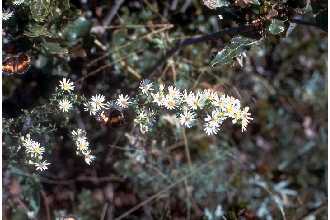White Heath Aster
Scientific Name: Symphyotrichum ericoides (L.) G.L. Nesom var. ericoides

| General Information | |
|---|---|
| Usda Symbol | SYERE |
| Group | Dicot |
| Life Cycle | Perennial |
| Growth Habits | Forb/herb |
| Native Locations | SYERE |
Plant Guide
Alternate Names
Aster ericoides, Aster ericoides forma caeruleus, Aster ericoides forma ericoides, Aster ericoides forma gramsii, Aster ericoides ssp. ericoides, Aster multiflorus, Aster multiflorus var. caeruleus, Aster multiflorus var. exiguous, Aster multiflorus var. pansus, Aster pansus, Aster polycephalus, Aster stricticaulis, blue aster, dense-flower aster, elongate aster, farewell-to-summer, goodbye-to-meadow, heath aster, Lasallea ericoides, squarrose white aster, Symphyotrichum ericoides, tufted white prairie aster, Virgus ericoides, white aster, white prairie aster, white-wreath aster, wreath aster.
Uses
Ethnobotanic: Native Americans used white heath aster in sweat baths. Flowering plants served as binding to the structure of the sweat lodge and were added to hot rocks to produce herbal steam. White heath aster was also used medicinally to revive unconscious patients. Economic: White heath aster is economically valuable as an ornamental. Gardening: The showy flowers of white heath aster make it a popular plant for use in wildflower and native plant gardens. Livestock and forage: Livestock will not consume white heath aster. It can lower the forage quality of prairie hay. Wildlife: White heath aster is a source of nectar and shelter for butterflies. It is resistant to deer browsing.
Legal Status
Status , Use soil moisture sensors to measure the soil moisture of White Heath Aster.
Status
White heath aster is endangered in Tennessee. Please consult the PLANTS Web site (http://plants.usda. gov) and your State Department of Natural Resources for this plant’s current status (e.g. threatened or endangered species, state noxious status, and wetland indicator values). Theodore S. Cochrane. Robert W. Freckmann Herbarium.
Weediness
White heath aster is reported to be invasive by Weeds of Nebraska and the Great Plains. This plant may become weedy or invasive in some regions or habitats and may displace desirable vegetation if not properly managed. Please consult with your local NRCS Field Office, Cooperative Extension Service office, or state natural resource or agriculture department regarding its status and use. Weed information is also available from the PLANTS Web site at plants.usda.gov.
Description
General: Aster family (Asteraceae). White heath aster is a hardy perennial with an extensive root system of rhizomes and stolons. This bushy plant grows to be 0.5 to 1 m tall and can have a 30 cm spread. Leaves are narrow (1cm wide) and linear (7 cm long), resembling the leaves of heather. At the time of flowering, most leaves drop except for those directly beneath the flower head. The remaining leaves are reduced to bracts. One plant can produce up to 100 flower heads. Ray flowers are white-to-pink, center disc flowers are yellowish-to-purple. Seeds are achenes that have tufts of white bristles to help them blow away with the wind. Flowering takes place August through November. White heath aster is difficult to distinguish from other white flowered species. A key characteristic is the blunt point of the bracts beneath the flower head. Other asters have sharply pointed bracts, bracts pressed against the inflorescence, or both. Distribution: White heath aster is native to the United States. It occurs from Maine to southern Saskatchewan, south to Virginia, Texas, northern Mexico and southeast Arizona. For current distribution, please consult the Plant Profile page for this species on the PLANTS Web site. Habitat: White heath aster is found in dry-mesic prairies, open black oak or jack pine woods, sand dunes and savanna communities. It is weedy in disturbed areas like roadsides, railroads, sandy fields, gravel pits and quarries, and sometimes riverbanks and lakeshores.
Adaptation
The USDA hardiness zones for white heath aster are 5 to 8. It is best adapted to dry and medium wet, well-drained soils found in open areas like prairies with sandy, gravelly, or rocky substrates. It is drought hardy and does well in sun and partial sun.
Establishment
Like other aster species, white heath aster seeds are ready for collection in September when achenes separate easily from the receptacle. Dry seeds prior to cleaning and store in sealed containers at 3 to 5oC. If sowing indoors, damp stratify white heath aster seeds at 1 to 2oC for 2.5 to 4 months. For springtime seeding, sow seeds either inside an unheated greenhouse or outside before the last frost. White heath aster can also be direct sown outdoors in the fall or mid-winter in covered containers, cold frames, or unheated greenhouses. Germination will occur within 2 weeks. Cut clumped plants into several separate pieces, each piece having buds and roots, to divide prairie plants like white heath aster. These “seedlings” can then be transplanted. Divisions should be made in late summer and transplanting can take place from September through November, or mid-April to mid-June. If not transplanting until spring, store potted seedlings in outdoor temperatures under insulating foam (if necessary).
Management
White heath aster resprouts from the underground stem after fire and responds to fire with vigorous growth the following growing season. As part of prairie restoration, prescribed burns should take place annually for the first 5 to 6 years, and biannually after the initial phase. Cultivars, Improved, and Selected Materials (and area of origin) The NRCS Plant Materials Program has not released any cultivars of white heath aster for conservation use. Ornamental cultivars of this species include ‘Blue Star,’ ‘Ester,’ ‘Monte Cassino,’ ‘Pink Cloud,’ ‘Pink Star,’ and ‘Snowflurry.’ Contact your local Natural Resources
Conservation
Service (formerly Soil Conservation Service) office for more information. Look in the phone book under ”United States Government.” The Natural Resources Conservation Service will be listed under the subheading “Department of Agriculture.”


